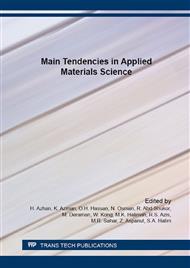p.69
p.75
p.80
p.85
p.91
p.96
p.102
p.107
p.115
Effects of H2 and CO on Electrical Properties of Pure SnO2 and Pt-Doped SnO2 Ceramics
Abstract:
Pure SnO2 and Pt doped SnO2 (0≤Pt≤10wt.%) ceramics have been successfully fabricated in the form of pellet by sintering at 1000 °C for 3 h. The resistance of the samples in air and in reducing gases (200 ppm H2 and 200 ppm CO) was determined by measuring current – voltage (I-V) characteristics via two-probe method between 150 to 450 °C. All samples show a decrease in resistance with an increase in temperature both in air and in gases. However, the values of resistance in gases are lower compared when the same samples were in air, due to gas molecules reactions with surface oxygen species which affect potential barrier to decrease and causes resistance to reduce. The resistance of the doped samples also increased by 279 - 1226% with an increase in Pt doping in SnO2, due to Pt surface states density.
Info:
Periodical:
Pages:
91-95
Citation:
Online since:
March 2016
Keywords:
Price:
Сopyright:
© 2016 Trans Tech Publications Ltd. All Rights Reserved
Share:
Citation:


